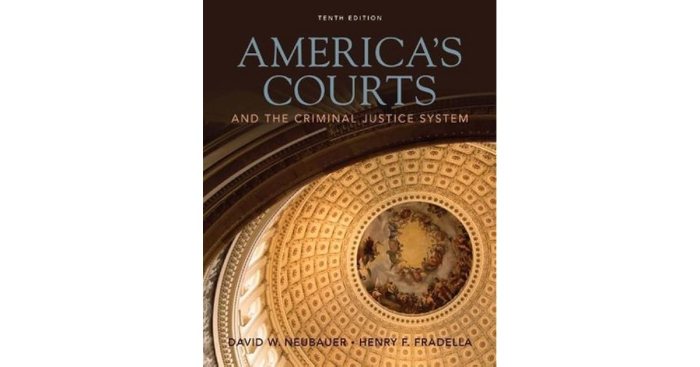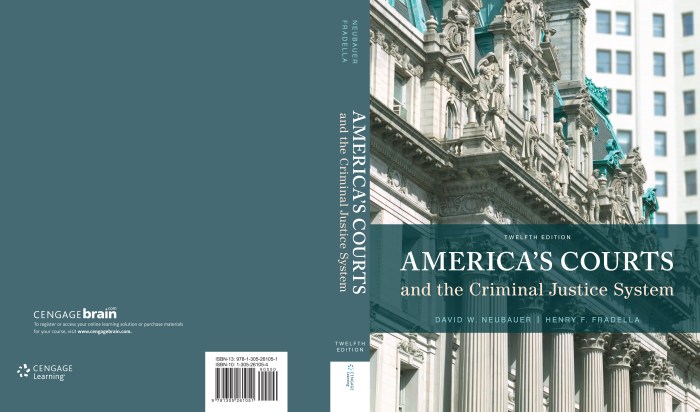America’s courts and the criminal justice system 13th edition pdf – Delve into the intricate world of America’s courts and the criminal justice system with the 13th edition of this seminal work. This comprehensive guide unveils the historical evolution, structure, procedures, challenges, and potential solutions within the American judicial system.
From the foundational principles of English common law to the landmark cases that have shaped constitutional jurisprudence, this text provides a thorough examination of the courts’ role in upholding justice and maintaining the delicate balance of power within the American government.
Historical Evolution of America’s Courts
The American court system has undergone a significant evolution since the founding of the nation. The roots of the system can be traced back to English common law, which was brought to the colonies by the early settlers. The U.S.
Constitution established the federal court system and granted it the power of judicial review, which has played a critical role in shaping the balance of power between the branches of government.
English Common Law and the Colonial Courts
The English common law system, which developed over centuries, provided the foundation for the American court system. Common law is based on the principle of stare decisis, which means that courts are bound to follow the precedents set by earlier decisions.
The U.S. Constitution and the Federal Court System
The U.S. Constitution established the federal court system and granted it the power of judicial review. This power allows the courts to declare laws unconstitutional, which has been a major factor in shaping the balance of power between the branches of government.
Judicial Review and the Balance of Power, America’s courts and the criminal justice system 13th edition pdf
The power of judicial review has played a critical role in shaping the balance of power between the branches of government. The courts have used this power to strike down laws that they deem to be unconstitutional, which has limited the power of the legislative and executive branches.
Structure and Organization of the Court System
The American court system is a complex and hierarchical system that includes both federal and state courts. The federal court system is divided into three levels: the Supreme Court, the courts of appeals, and the district courts. The state court systems are also typically divided into three levels: the supreme court, the intermediate appellate courts, and the trial courts.
Hierarchy of Federal and State Courts
The Supreme Court is the highest court in the United States. It has the power to review decisions from the lower federal courts and from the state supreme courts. The courts of appeals are the intermediate appellate courts in the federal system.
They review decisions from the district courts.
Subject-Matter Jurisdiction and Personal Jurisdiction
Courts have subject-matter jurisdiction over certain types of cases. For example, federal courts have subject-matter jurisdiction over cases involving federal law. Personal jurisdiction refers to the court’s authority over the parties to a case.
Role of Appellate Courts
Appellate courts review decisions from lower courts. They can uphold the lower court’s decision, reverse it, or send it back for further proceedings.
Criminal Procedure

Criminal procedure refers to the steps involved in a criminal case, from arrest to sentencing. The Fourth, Fifth, Sixth, and Eighth Amendments to the U.S. Constitution protect the rights of the accused during criminal proceedings.
Steps in a Criminal Case
The steps in a criminal case typically include: arrest, arraignment, preliminary hearing, trial, and sentencing.
Rights of the Accused
The Fourth Amendment protects against unreasonable searches and seizures. The Fifth Amendment protects against self-incrimination and double jeopardy. The Sixth Amendment guarantees the right to a fair trial, including the right to an attorney. The Eighth Amendment prohibits cruel and unusual punishment.
Plea Bargaining and Mandatory Minimum Sentences
Plea bargaining is a process in which the defendant agrees to plead guilty to a lesser charge in exchange for a reduced sentence. Mandatory minimum sentences are sentences that are required by law, regardless of the circumstances of the case.
Sentencing and Corrections

Sentencing refers to the process of determining the punishment for a convicted criminal. Corrections refers to the system of institutions and programs that are used to punish and rehabilitate criminals.
Types of Sentences
The types of sentences available to courts include: incarceration, probation, and parole.
Factors Influencing Sentencing Decisions
The factors that influence sentencing decisions include: the severity of the crime, the defendant’s criminal history, and the defendant’s personal circumstances.
Effectiveness of Correctional Programs
The effectiveness of correctional programs in reducing recidivism is a matter of debate. Some studies have shown that correctional programs can be effective in reducing recidivism, while other studies have shown that they have little or no effect.
Challenges Facing the Criminal Justice System
The criminal justice system faces a number of challenges, including mass incarceration, racial disparities, and the lack of access to legal representation.
Mass Incarceration
The United States has the highest incarceration rate in the world. This is due in part to the war on drugs and the mandatory minimum sentencing laws that were passed in the 1980s and 1990s.
Racial Disparities
There are significant racial disparities in the criminal justice system. African Americans are more likely to be arrested, convicted, and sentenced to prison than whites, even for the same crimes.
Lack of Access to Legal Representation
Many people who are accused of crimes cannot afford to hire an attorney. This can lead to unfair outcomes, as people who cannot afford an attorney are more likely to be convicted and sentenced to prison.
Potential Solutions
There are a number of potential solutions to the challenges facing the criminal justice system. These include: reforming sentencing policies, investing in community-based programs, and increasing access to legal representation.
Answers to Common Questions: America’s Courts And The Criminal Justice System 13th Edition Pdf
What are the key principles of subject-matter jurisdiction?
Subject-matter jurisdiction refers to the authority of a court to hear and decide a particular type of case. It is determined by the nature of the legal claims being made and the relief being sought.
How does the role of appellate courts differ from that of trial courts?
Appellate courts review decisions made by lower courts to determine if any errors were made in the application of the law or the interpretation of the facts. They do not conduct new trials but rather examine the record of the proceedings below.
What factors are considered in sentencing decisions?
Sentencing decisions are influenced by a variety of factors, including the severity of the crime, the offender’s criminal history, the potential for rehabilitation, and the need to protect society.